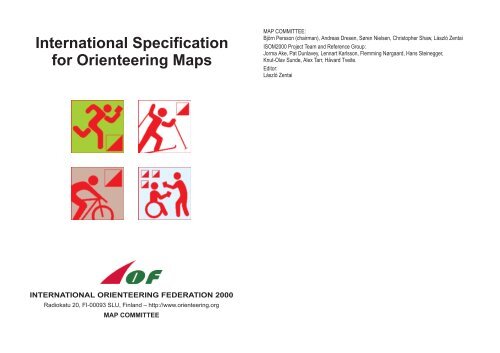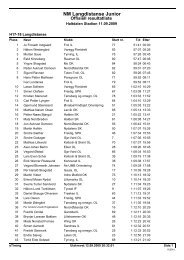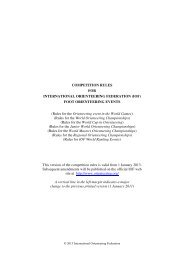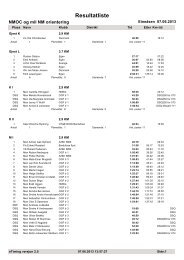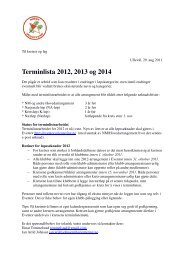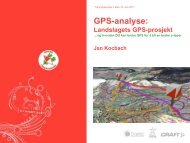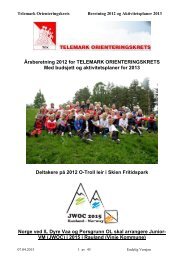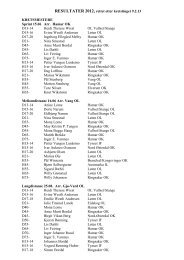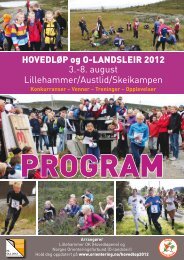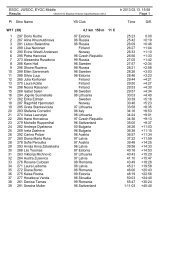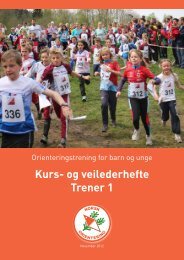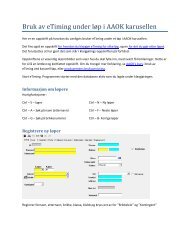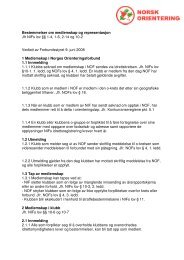International Specification for Orienteering Maps
International Specification for Orienteering Maps
International Specification for Orienteering Maps
Create successful ePaper yourself
Turn your PDF publications into a flip-book with our unique Google optimized e-Paper software.
OverprintingWith traditional spot colour printing inks are physically printed on top of each other. It is possible to simulate thesame with four-colour printing technique, and this optimises legibility and gives a colour appearance as close totraditional spot colour printing as possible. To achieve this effect in four-colour offset printing, in<strong>for</strong>mationunderlying (in the spot colour printing order described in 3.5.1) a specific spot colour should not be blocked out(erased / printed white) completely, but should be blended in to produce a new colour <strong>for</strong> printing.The use of overprinting effect with 4-color offset printing is recommended <strong>for</strong> the following solid colors:• 100 % Violet• 100 % Black• 100 % Brown• 100 % Blue• 100 % GreenIllustration: Contours in dense vegetation printed in 4-colours. Overprinting effect in the right illustration.3.5.3 Alternative printing methodsColour copiers, printers and other digital printing equipment are not yet suitable <strong>for</strong> printing orienteering maps <strong>for</strong>high level competitions. It is very difficult to achieve the line quality, legibility and colour appearance of traditionalspot colour printed maps using this kind of equipment.It is expected that the continuing development of computer technology will lead to the possibility of usingalternative printing methods with quality suitable <strong>for</strong> large competitions.Most printing devices use a 4-color technique (CMYK). For such devices the same colour settings as recommended<strong>for</strong> 4-color offset printing may be suitable, but the colour appearance will vary slightly from one device toanother and from one paper quality to another.Extensive experimentation with different colour and halftone settings, different paper qualities and othervariables will be necessary to achieve a quality as close to offset printing as possible. Such experimentation hasto be done <strong>for</strong> a whole range of devices. This specification can there<strong>for</strong>e not give any general recommendations<strong>for</strong> the use of such alternative printing methods.74 EXPLANATION OF SYMBOLS (FOOT-O)Definitions of map features and specifications <strong>for</strong> the drawing of symbols are given in the following sections.Symbols are classified into 7 categories:Land <strong>for</strong>msRock and bouldersWater and marshVegetationMan-made featuresTechnical symbolsCourse symbols4.1 Land <strong>for</strong>ms(brown)(black+grey)(blue)(green+yellow)(black)(black+blue)(purple)Note: dimensions arespecified in mm at thescale of 1:15 000.All drawings are at1:7 500 <strong>for</strong> clarity only.gap or infill between two linesline thicknessdistance from centre to centreor length of linediametersymbol orientated to northThe shape of land is shown by means of very detailed contours, aided by the special symbols <strong>for</strong> small knolls,depressions, etc. This is complemented in black by the symbols <strong>for</strong> rock and cliffs. <strong>Orienteering</strong> terrain is normallybest represented witha5mcontour interval.Excessive use of <strong>for</strong>m lines should be avoided as this will complicate the map and give a wrong impression ofheight differences. If the representation of an area needs a large number of <strong>for</strong>m lines, a smaller contour intervalprovides a more legible alternative.The relative height difference between neighbouring features must be represented on the map as accurately aspossible. Absolute height accuracy is of less importance. It is permissible to alter the height of a contour slightly ifthis will improve the representation of a feature. This deviation should not exceed 25% of the contour interval andattention must be paid to neighbouring features.101 ContourA line joining points of equal height. The standard vertical interval between contours0.14 is 5 metres. The smallest bend in a contour is 0.25 mm from centre to centre of thelines.Colour: brown.0.2580.51.25102 Index contourEvery fifth contour shall be drawn with a thicker line. This is an aid to the quick0.25 assessment of height difference and the overall shape of the terrain surface. Wherean index contour coincides with an area of much detail, it may be shown with a normalcontour line.Colour: brown.103 Form lineAn intermediate contour line. Form lines are used where more in<strong>for</strong>mation can begiven about the shape of the ground. They are used only where representation is not0.14 possible with ordinary contours. Only one <strong>for</strong>m line may be used between neighbouringcontours.Colour: brown.104 Slope lineSlope lines may be drawn on the lower side of a contour line, e.g. along the line of a reentrantor in a depression. They are used only where it is necessary to clarify the0.14direction of slope.Colour: brown.
0.140.141.25 0.250.50.250.25ø 0.250.180.50.20.10.3min. 0.50.90.30.1 0.25min.0.80.180.80.180.80.18306 Crossable small watercourseA crossable watercourse (including a major drainage ditch) less than 2 m wide. Forbetter legibility a ditch in a marsh should be drawn as a crossable watercourse (305).Colour: blue.307 Minor water channelA natural or man-made minor water channel which may contain water only intermittently.Colour: blue.308 Narrow marshA marsh or trickle of water which is too narrow to be shown with symbol 310 (less thanca. 5 m wide).Colour: blue.309 Uncrossable marshA marsh which is uncrossable or dangerous <strong>for</strong> the runner. A black line surrounds thesymbol.Colour: blue, black.310 MarshA crossable marsh, usually with a distinct edge. The symbol should be combined withvegetation symbols to show runnability and openness. Where a small marsh areashould be combined with either 403/404 it is permitted to use 401/402 to improvelegibility.Colour: blue.311 Indistinct marshAn indistinct or seasonal marsh or area of gradual transition from marsh to firmground, which is crossable. The edge is generally indistinct and the vegetation similarto that of the surrounding ground. The symbol should be combined with vegetationsymbols to show runnability and openness.Colour: blue.312 WellWells and captive springs, which are clearly visible on the ground.Colour: blue.313 SpringThe source of a stream with a distinct outflow. The symbol is orientated to opendownstream.Colour: blue.314 Special water featureA special small water feature. The definition of the symbol must always be given in themap legend.Colour: blue.4.4 VegetationThe representation of vegetation is important to the orienteer because it affects runnability and visibility and italso provides features <strong>for</strong> map reading.COLOURThe basic principle is as follows:- white represents runnable <strong>for</strong>est,- yellow represents open areas divided into several categories,- green represents the density of the <strong>for</strong>est and undergrowth according to its runnability and is divided intoseveral categories.RUNNABILITY.The runnability depends on the nature of the <strong>for</strong>est (density of trees/brushwood and undergrowth—bracken,brambles, nettles, etc.) but does not take account of marshes, stony ground etc. which are shown by separatesymbols.Runnability in <strong>for</strong>est is divided into 4 categoriesaccording to running speed. If speed through typicallyopen runnable <strong>for</strong>est is, <strong>for</strong> example, 5 min/km, thefollowing ratios apply:open <strong>for</strong>estslow runningdifficult to runvery difficult to run80-100%60-80%20-60%0-20%Note: dimensions arespecified in mm atthe scale of 1:15 000.All drawings are at1:7 500 <strong>for</strong> clarity only.ø 0.40.55- 6:15 min/km6:15 - 8:20 min/km8:20 - 25:00 min/km> 25:00 min/km100806020distance covered200 600 800 1000 mspeed in typicallyopen <strong>for</strong>est401 Open landCultivated land, fields, meadows, grassland, etc. without trees, offering easy running.If yellow coloured areas becomes dominant, a screen (75%) instead of full yellow100%may be used.Colour: yellow.50%runnabilty (%)402 Open land with scattered treesMeadows with scattered trees or bushes, with grass or similar ground cover offering2easy running. Areas smaller than 10 mm at the maps scale are shown as open land(401). Individual trees may be added (418, 419, 420). If yellow coloured areasbecomes dominant, a screen (75%) instead of full yellow may be used.Colour: yellow (20 lines/cm).403 Rough open landHeath, moorland, felled areas, newly planted areas (trees lower than ca. 1 m) or other50% generally open land with rough ground vegetation, heather or tall grass. Symbol 403may be combined with symbols 407 and 409 to show reduced runnability.Colour: yellow 50% (60 lines/cm).1314
ø 0.550.70.120.120.720.300.840.42(36%)30%60%404 Rough open land with scattered treesWhere there are scattered trees in rough open land, areas of white (or green) shouldappear in the tone. Such an area may be generalised by using a regular pattern of2large white dots in the yellow screen. Areas smaller than 16 mm in the maps scaleare shown as rough open land (403). Individual trees may be added (418, 419, 420).Colour: yellow 70% (60 lines/cm), white 48.5% (14.3 lines/cm).405 Forest: easy runningTypically open runnable <strong>for</strong>est <strong>for</strong> the particular type of terrain. If no part of the <strong>for</strong>estis runnable then no white should appear on the map.Colour: white.406 Forest: slow runningAn area with dense trees (low visibility) which reduces running to ca. 60-80% ofnormal speed.Colour: green 30% (60 lines/cm).407 Undergrowth: slow runningAn area of dense undergrowth but otherwise good visibility (brambles, heather, lowbushes, and including cut branches) which reduces running to ca. 60-80% of normalspeed. This symbol may not be combined with 406 or 408.Colour: green 14.3% (11.9 lines/cm).408 Forest: difficult to runAn area with dense trees or thicket (low visibility) which reduce running to ca. 20-60%of normal speed.Colour: green 60% (60 lines/cm).409 Undergrowth: difficult to runAn area of dense undergrowth but otherwise good visibility (brambles, heather, lowbushes, and including cut branches) which reduces running to ca. 20-60% of normalspeed. This symbol may not be combined with 406 or 408.Colour: green 28.6% (23.8 lines/cm).100%YELLOWø 0.20.50.8ø 0.50.8BLACK0.12ø 0.224.5 Man-made featuresNote: dimensions arespecified in mm atthe scale of 1:15 000.All drawings are at1:7 500 <strong>for</strong> clarity only.414 Distinct cultivation boundaryThe boundary of cultivated land when not shown with other symbols (fence, wall,path, etc.) is shown with a black line. A permanent boundary between different typesof cultivated land is also shown with this symbol.Colour: black.415 Cultivated landCultivated land which is seasonally out-of-bounds due to growing crops may beshown with a black dot screen.Colour: yellow 100%, black 5% (12.5 lines/cm).416 Distinct vegetation boundaryA distinct <strong>for</strong>est edge or very distinct vegetation boundary within the <strong>for</strong>est.Colour: black.417 Indistinct vegetation boundaryIndistinct boundaries between areas of green, yellow or white are shown without aline. The edge of the area is shown only by the change in colour or dot screen.418, 419, 420 Special vegetation featuresSymbols 418, 419 and 420 can be used <strong>for</strong> special small vegetation features. The0.18definition of the symbol must be given in each case in the map legend.Colour: green.The track network provides important in<strong>for</strong>mation <strong>for</strong> the runner and the classificationmust be clearly recognisable on the map. Particularly important <strong>for</strong> the competitor isthe classification of smaller paths. Account must be taken not only of the width, butalso of how obvious the path is to the runner.Other man-made features are also important both <strong>for</strong> map reading and as controlpoints.1.5YELLOWø 0.45 0.8GREEN0.2 0.85min.0.250.41.30.6410 Vegetation: very difficult to run, impassableAn area of dense vegetation (trees or undergrowth) which is barely passable.Running reduced to ca. 0-20% of normal speed.Colour: green 100%.411 Forest runnable in one directionWhen an area of <strong>for</strong>est provides good running in one direction but less good in others,white stripes are left in the screen symbol to show the direction of good running.Colour: green, white.412 OrchardLand planted with fruit trees or bushes. The dot lines may be orientated to show thedirection of planting. If yellow coloured areas becomes dominant, a screen (75%)instead of full yellow may be used.Colour: yellow and green 25% (12.5 lines/cm).413 VineyardThe green lines may be orientated to show the direction of planting. If yellow colouredareas becomes dominant, a screen (75%) instead of full yellow may be used.Colour: yellow and green.15min. 0.30.25 3.0min. 0.50.25 3.0160.180.18501 MotorwayA road with two carriageways. The width of the symbol should be drawn to scale butnot smaller than the minimum width. The outer boundary lines may be replaced withsymbols 519, 521, 522 or 524 if a fence or wall is so close to the motorway edge that itcannot practically be shown as a separate symbol. The space between the blacklines must be filled with brown (50%). A road under construction may be shown withbroken lines.Colour: black and brown 50% (60 lines/cm).502 Major roadRoad wider than 5m. The width of the symbol should be drawn to scale but not smallerthan the minimum width. The outer boundary lines may be replaced with symbols519, 521, 522 or 524 if a fence or wall is so close to the motorway edge that it cannotpractically be shown as a separate symbol. The space between the black lines mustbe filled with brown (50%). A road under construction may be shown with brokenlines.Colour: black and brown 50% (60 lines/cm).
0.30.25 3.00.253.00.252.00.251.00.251.00.53.00.250.50.180.350.350.250.180.180.14503 Minor roadRoad 3-5 m wide. The space between the black lines must be filled with brown (50%).A road under construction may be shown with broken lines.Colour: black and brown 50% (60 lines/cm).504 RoadA maintained road suitable <strong>for</strong> motor vehicles in all weather. Width less than 3 m.Colour: black.505 Vehicle trackA track or poorly maintained road suitable <strong>for</strong> vehicles only when travelling slowly.Width less than 3 m.Colour: black.506 FootpathA large path, or old vehicle track, which is distinct on the ground.Colour: black.507 Small pathA small path or (temporary) <strong>for</strong>est extraction track which can be followed at competitionspeed.Colour: black.508 Less distinct small pathA less distinct small path or <strong>for</strong>estry extraction track.Colour: black.509 Narrow rideA distinct ride, less than ca. 5 m wide. A ride is a linear break in the <strong>for</strong>est (usuallyplantation) which does not have a distinct path along it. Where there is a path along aride, symbols 507 or 508 should be used in place of symbol 509.Colour: black.510 Visible path junctionWhen a junction or intersection of paths or tracks is visible, the dashes of the symbolsare joined at the junction.Colour: black.511 Indistinct junctionWhen a junction or intersection of paths or tracks is not clear, the dashes of thesymbols are not joined.Colour: black.512 FootbridgeA footbridge with no path leading to it.Colour: black.513 Crossing point with bridgeA path or track crossing a river, stream or ditch by a bridge.Colour: black.514 Crossing point without bridgeA path or track crossing a river, stream or ditch without a bridge.Colour: black.3.00.30.32.52.50.252.50.50.352.52.50.70.660º0.35ø 0.4ø 0.4ø 0.560º0.252.5 0.60.50.60.50.180.140.14min.0.5 x 0.50.350.140.140.180.140.140.180.140.140.18515 RailwayA railway or other kind of railed track (tramway, truckway, etc.).Colour: black.516 Power linePower line, cableway or skilift. The bars indicate the exact location of the pylons.Colour: black.517 Major power lineMajor power lines should be drawn with a double line. The gap between the lines mayindicate the extent of the powerline.Colour: black.518 TunnelA way under roads, railways, etc. which may be used by the runner. This symbol isused whether or not the tunnel has a track leading to it.Colour: black.519 Stone wallA stone wall or stone-faced bank.Colour: black.520 Ruined stone wallA ruined stone wall may be shown by a dashed line.Colour: black.521 High stone wallA stone wall higher than ca 1.5 m, not crossable to the average orienteer.Colour: black.522 FenceA wooden or wire fence less than ca. 1.5 m high.Colour: black.523 Ruined fenceA ruined fence may be shown with a dashed line.Colour: black.524 High fenceA boarded or wire fence higher than ca 1.5 m, not crossable to the average orienteer,eg. deer fence.Colour: black.525 Crossing pointAll ways through or over high fences or walls must be indicated. The symbol may alsobe used <strong>for</strong> a gate through or stile over a stone wall (519) or a fence (522) or a pipeline(534).Colour: black.526 BuildingA building is shown with its ground plan so far as the scale permits.Colour: black.1718
YELLOW GREEN100% 50%alternative BLACK0.120.250.35 0.25 0.550%0.12527 SettlementHouses and gardens and other built up areas. Roads, buildings and other significantfeatures within a settlement must be shown. If all buildings cannot be shown, analternative symbol (black line screen) may be used.Colour: green 50% (60 l/cm) and yellow 100% or alternatively black 32.5% (27 l/cm) .528 Permanently out of boundsAreas which are permanently <strong>for</strong>bidden to the runner are shown as out of bounds.The screen is superimposed on the normal map detail. A bounding line may be drawnif there is no natural boundary (see 709).Colour: black or purple 33.3% (13.3 lines/cm).529 Paved areaAn area of hard standing used <strong>for</strong> parking or other purposes.Colour: black and brown 50% (60 lines/cm).0.81.00.8ø 0.141.060º0.80.160.160.16537 CairnCairn, memorial stone or boundary stone (or a trigonometric point in some countries)more than 0.5 m high.Colour: black.538 Fodder rackA fodder rack which is free standing or built on to a tree. Location is at the centre ofgravity of the symbol. For land access reasons these may be omitted.Colour: black.539, 540 Special man-made featuresSpecial man-made features are shown with these symbols. The definition of thesymbols must be given in each case in the map legend.Colour: black.1.40.140.252.50.252.50.6min.0.8 x 0.80.71.0 0.31.02.0ø 0.80.31.00.545º45º0.50.160.160.350.160.140.180.16530 RuinThe ground plan of a ruin is shown to scale, down to the minimum size shownopposite. Very small ruins may be drawn with a solid line.Colour: black.531 Firing rangeA firing range is shown with a special symbol to indicate the need <strong>for</strong> caution.Associated buildings are individually marked.Colour: black.532 GraveA distinct grave marked by a stone or shrine. Location is at the centre of gravity of thesymbol, which is orientated to north. A cemetery is shown by using grave symbols asspace permits.Colour: black.533 Crossable pipelineA pipeline (gas, water, oil, etc.) above ground level which can be crossed over orunder.Colour: black.534 Uncrossable pipelineA pipeline which cannot be crossed.Colour: black.535 High towerA high tower or large pylon, standing above the level of the surrounding <strong>for</strong>est.Location is at the centre of gravity of the symbol.Colour: black.536 Small towerAn obvious shooting plat<strong>for</strong>m or seat, or small tower. Location is at the centre ofgravity of the symbol.Colour: black.4.6 Technical symbolsNote: dimensions arespecified in mm atthe scale of 1:15 000.All drawings are at1:7 500 <strong>for</strong> clarity only.min.4mmø 0.30.14321 1.5540.180.1Technical symbols are such symbols which are essential on all kinds of topographicmaps and not only on orienteering maps.601 Magnetic north lineMagnetic north lines are lines placed on the map pointing to magnetic north. Theirspacing on the map should be 33.33 mm which represents 500 m on the ground at thescale of 1:15 000. For maps with other scales lines placing should be at intervalswhich represents a round number of meters (e.g. 50 m, 100 m, 250 m, 500 m) and thespacing should be between 20 mm and 40 mm on the map. North lines may be brokenwhere they obscure small features such as boulders, knolls, cliffs, stream junctions,path ends, etc. In areas with very few water features, blue lines may be used.Colour: black (blue).602 Registration marksAt least three registration marks must be placed within the frame of a map in a nonsymmetricalposition. In addition, a colour check should also be possible.Colour: all printed colours.603 Spot heightSpot heights are used <strong>for</strong> the rough assessment of height differences. The height isgiven to the nearest metre. The figures are orientated to the north. Water levels aregiven without the dot.Colour: black.1920
4.7 Overprinting symbolsNote: dimensions arespecified in mm at thethe printed scale of1:15 000. Drawings inthis section are at1:15 000 also.ø 6.04.07.0180.350.350.35Courses should be overprinted at least <strong>for</strong> elite classes. For other classes they can bedrawn by hand.The size of overprinting symbols is given <strong>for</strong> 1:15 000 maps. The size of thesesymbols <strong>for</strong> 1:10 000 maps should be the same as <strong>for</strong> 1:15 000 maps. However, <strong>for</strong>multi-age competitions in which both 1:10 000 and 1:15 000 maps are used, the sizeof the symbols on the 1:10 000 maps may be 150% greater than on the 1:15 000maps.701 StartThe start or map issue point (if not at the start) is shown by an equilateral trianglewhich points in the direction of the first control. The centre of the triangle shows theprecise position of the start point.Colour: purple.702 Control pointThe control points are shown with circles. The centre of the circle shows the preciseposition of the feature. Sections of circles should be omitted to leave important detailshowing.Colour: purple.703 Control numberThe number of the control is placed close to the control point circle in such a way thatit does not obscure important detail. The numbers are orientated to north.Colour: purple.0.25 0.60.5 3.0 0.250.63.00.250.353.01.03.03.00.35709 Out-of-bounds areaAn out-of-bounds area, see also symbol 528, is shown with vertical stripes.A bounding line may be drawn if there is no natural boundary, as follows:- a solid line indicates that the boundary is marked continuously (tapes, etc.) on theground,- a dashed line indicates intermittent marking on the ground,- no line indicates no marking on the ground.Colour: purple.710 Dangerous areaAn area presenting danger to the competitor is shown with cross-hatched diagonallines.Colour: purple.711 Forbidden routeA route which is out-of-bounds is shown with crosses..Colour: purple.712 First aid postThe location of a first aid post.Colour: purple.713 Refreshment pointThe location of a refreshment point which is not at a control.Colour: purple.90.35704 LineWhere controls are to be visited in order, the start, control points and finish are joinedtogether by straight lines. Sections of lines should be omitted to leave important detailshowing.Colour: purple.0.52.00.35705 Marked routeA marked route is shown on the map with a dashed line.Colour: purple.ø 5.0ø 7.00.350.7706 FinishThe finish is shown by two concentric circles.Colour: purple.707 Uncrossable boundaryA boundary which it is not permitted to cross.Colour: purple.0.63.00.35708 Crossing pointA crossing point through or over a wall or fence, or across a road or railway or througha tunnel or an out-of-bounds area is drawn on the map with two lines curving outwards.Colour: purple.2122
5 MAP SPECIFICATION FOR SKI-ORIENTEERING5.1 General<strong>Maps</strong> <strong>for</strong> ski orienteering are based on the specifications <strong>for</strong> foot-orienteering maps. However in order to meetthe specific requirements put on the map by the nature of ski orienteering, certain deviations and additions to thefoot-orienteering map specification is needed. These special rules and symbols are described in this chapter.Deviations from the specifications are permissible only with the sanction of the national Ski-O Committee. Forinternational events, sanction must be given by the IOF Ski-O Committee.Complete foot-orienteering maps may be used in ski-o competitions at all levels, if the dark green (symbol 410) isreplaced by light green (symbol 406). For international events, permission from the IOF Ski-O Committee isrequired.5.2 ContentSki orienteering is a sport in which the ski-orienteer uses the map to navigate a track and route network in orderto visit a number of control points. In ski-o the competitor's skiing and navigation skills shall be tested in such waythat the navigation skill becomes the decisive element.Ski orienteering takes place in the track network, and involves as a basic element complex route choice problems,including the estimating of height differences. It is obvious that the map must concentrate on clearlydepicting these features. The map must also be legible when skiing at high speed. This means that the mapshould omit a large part of details in “free“ terrain in order to exaggerate the track network and to simplify thepresentation of the shape of the ground. Only details that impact a) route choice and b) navigation and positioning,need be shown on the map.In order to accomplish fairness in route choice, additional symbols need to be introduced. These symbolsdescribe the quality and width of the tracks.5.3 ScaleThe maps scale shall be 1:15 000 or 1:10 000. A different scale may be used, but permission shall be obtainedfrom the IOF Ski-O Committee at IOF ski-o events and from the national Ski-O Committee <strong>for</strong> other events.The magnification in scale has made it possible to build a more dense and easily legible track network.Furthermore, the error probability has decreased, as the shapes of the junctions and the departure angles of thetracks can be drawn correctly on the map.5.4 Contour intervalThe contour interval is 5 m. A different interval (2.5 m or 10 m) may be used, but permission shall be obtainedfrom the IOF Ski-O Committee at IOF ski-o events and from the national Ski-O Committee <strong>for</strong> other events.5.5 Printing and reproductionSki-orienteering maps are often updated very close to a competition. The track network may be revised only afew days be<strong>for</strong>e an event. There<strong>for</strong>e new printing methods, like digital offset, colour copying etc. is well suited <strong>for</strong>23ski-orienteering maps. However, <strong>for</strong> IOF events such as World Championships and World Cup, spot colouroffset is still the recommended method.When using alternative printing methods, it is important to make sure that the overprint effect between green andblack is maintained. The rule is that when overprinting a green track on a black path, the path must be visiblethrough the green, and not totally cleared out. When printing offset, green is the last colour ("overprint") and thiseffect is automatically achieved, but when using digital methods this effect must be controlled through thesoftware.Please refer also to section 3.4 Printing, in this publication.5.6 Recommended symbols5.6.1 Use of foot-o symbolsThe following symbols from the foot-orienteering map specification are recommended <strong>for</strong> the ski orienteeringmap.Land <strong>for</strong>msThe shape of land is shown by means of contours. In order to maintain legibility of the map when skiing at highspeed the contour lines may be more generalised in comparison to foot-o maps. Form lines shall be omitted.101 Contour, 102 Index contour, 104 Slope line, 105 Contour value, 106 Earth bank, 109 Erosion gully, 111 Knoll,114 Depression.Rock and bouldersRocks and boulders are not likely to affect route choices, but in its prominent <strong>for</strong>ms they can serve as valuableobject <strong>for</strong> navigation and positioning. The map may show these features when they are visible to the competitorwhen the terrain is covered with snow.201 Impassable cliff, 202 Rock pillars/cliffs, 206 Boulder, 207 Large boulder, 208 Boulder field, 209 Bouldercluster.Water and marshBesides navigation and positioning, this group is important to the competitor as it facilitates the interpretation ofheight (what is " up" and what is " down") in maps with complex contouring.301 Lake, 304 Uncrossable river, 305 Crossable watercourse, 306 Crossable small watercourse, 309 Uncrossablemarsh, 310 Marsh.Open land and vegetationThe representation of vegetation is of importance to the competitor mainly <strong>for</strong> navigational purposes, but couldbe used <strong>for</strong> route choices in cases where the competitor chooses to try shortcuts in free terrain. In order not todestroy legibility of the green tracks, all vegetation screens must be drawn with the symbol 406 Forest:Slow running.401 Open land, 402 Open land with scattered trees, 403 Rough open land, 404 Rough open land with scatteredtrees, 405 Open <strong>for</strong>est, 406 Forest: slow running, 412 Orchard, 413 Vineyard, 414 Distinct cultivation boundary416 Distinct vegetation boundary, 418, 419 Special vegetation features.Man-made features501 Motorway, 502 Major road, 503 Minor road, 504 Road, 505 Vehicle track, 506 Footpath, 507 Small path (notto be seen when covered with snow), 509 Narrow ride, 515 Railway, 516 Power line, 517 Major power line, 518Tunnel, 519 Stone wall, 521 High stone wall, 522 Fence, 524 High fence, 525 Crossing point, 526 Building, 527Settlement, 529 Paved area, 532 Firing range, 534 uncrossable pipeline, 536 High tower, 540,541 Special manmadefeatures.24
5.6.2 Discipline-specific symbolsThe following symbols are introduced <strong>for</strong> ski orienteering maps.Track overprintThe track network is indicated by green symbols <strong>for</strong> track width. When a track follows a path, the green issuperimposed on the path. The symbols are drawn with a compact and clearly visible shade of green (PMS 354is recommended). Opened skiable dirt roads are shown only with black. (Roads that are cleared from snow butstill skiable are only shown with black.)Note: dimensions arespecified in mm atthe scale of 1:15 000.All drawings are at1:7 500 <strong>for</strong> clarity only.ø 0.50.53.00.50.94.00.5(0.35)0.5(0.35)0.5(0.35)If a road printed in black is not open, but has tracks on it, a track must be printed ingreen beside the road.A route or road which is out-of-bounds is shown by the general symbol 711 Forbiddenroute, printed in purple.All junctions and crossings must be drawn solid in order to clarify the exact position ofthe junction or crossing. This is valid also <strong>for</strong> dotted tracks.801 Track >2 mTrack wider than 2.0 m.Colour: green.The thinner line can be used in areas with very dense track network.802 Track 1-2 mTrack 1-2 m wide.Colour: green.The thinner line can be used in areas with very dense track network.803 Track 0.8-1 mNarrow, soft, winding track with 0.8-1 m width. The symbols is also used <strong>for</strong> difficultslopes.Colour: green.The smaller dots can be used in areas with very dense track network.804 Road covered with snowA road on the map covered with snow during the competition. The symbol is a cross0.5 line across the road. The symbol can also be used on green track symbols to showthat the track is not opened.Colour: green.6 MAP SPECIFICATION FOR MOUNTAIN BIKE ORIENTEERING6.1 General<strong>Maps</strong> <strong>for</strong> mountain bike orienteering are based on the specifications <strong>for</strong> foot-orienteering maps. However inorder to meet the specific requirements put on the map by the nature of mountain bike orienteering, certaindeviations and additions to the foot-orienteering map specification are needed. These special rules and symbolsare described in this chapter.6.2 ContentMountain bike orienteering is a sport in which the bike-orienteer uses the map to navigate a track and pathnetwork in order to visit a number of control points. The competitor must always stay on the track and paths andis not allowed to cycle freely in the terrain. This rule is important <strong>for</strong> the requirements of the map.Mountain bike orienteering takes place on the track and path network and involves as a basic element complexroute choice problems, including the estimating of height differences. It is obvious that the map must concentrateon clearly depicting these features. The map must also be legible when cycling at high speed. This means thatthe map should omit a large number of details in "free" terrain in order to exaggerate the track and path networkand to simplify the presentation of the shape of the ground. Only details that impact a) route choice and b)navigation and positioning, need be shown on the map.In order to accomplish fairness in route choice, additional symbols need to be introduced. These symbolsdescribe the quality and width of the tracks and paths.6.3 Scale and map sizeThe scale <strong>for</strong> mountain bike orienteering maps range from 1:10 000 to 1:30 000. <strong>Maps</strong> at 1:10 000 may beproduced <strong>for</strong> the shorter distances while 1:30 000 is suitable <strong>for</strong> the long distances. The size of the map sheetmust not exceed 300 mm by 300 mm.Independent of scale, maps should be drawn with lines, line screens and symbol sizes as specified <strong>for</strong> the 1:15000 maps. This is especially important since the line widths <strong>for</strong> tracks and paths present in<strong>for</strong>mation about theclassification.5.00.560°0.50.18805 Sanded or snowless roadA road on the map which is sanded or snowless during the competition is shown by achain of V-symbols across the road.Colour: green.806 Prepared areasPrepared slalom slopes and similar areas.Colour: green.6.4 Contour intervalThe contour interval <strong>for</strong> mountain bike orienteering maps is 5 m. In very hilly terrain an interval of 10 m may beused. Note: The same interval must be used all over the map!6.5 Printing and reproduction2.0Even though new printing methods, like digital offset, colour copying etc. is developing rapidly, traditional offsetis still superior in quality when printing detailed maps. For IOF events such as World Championships and WorldCup this is the recommended method. However, if alternative methods produces maps with the same quality astraditional spot colour offset printing, they will be accepted.2526
For smaller competitions, maps are likely to be reproduced in relatively small quantities and <strong>for</strong> this the new andcheaper printing methods are well suited.Please refer also to section 3.4 Printing, in this publication.6.6 Recommended symbols6.6.1 Use of foot-o symbolsThe following symbols from the foot-orienteering map specification are recommended <strong>for</strong> the mountain bikeorienteering map.Land <strong>for</strong>msThe shape of land is shown by means of contours. In order to maintain legibility of the map with scales down to1:30 000, when cycling at high speed the contour lines may be more generalised in comparison to foot-o maps.Form lines shall be omitted.101 Contour, 102 Index contour, 104 Slope line, 105 Contour value, 106 Earth bank, 109 Erosion gully, 111 Knoll,114 Depression.Rock and bouldersRocks and boulders are not likely to affect route choice, but where prominent they can serve as valuable features<strong>for</strong> navigation and positioning. The map may show these features when they are visible to the competitor.201 Impassable cliff, 202 Rock pillars/cliffs, 207 Large boulder, 208 Boulder field, 209 Boulder cluster, 211 Opensandy ground, 212 Bare rock.Water and marshBesides navigation and positioning, this group is important to the competitor as it facilitates the interpretation ofheight (what is "up" and what is "down") in maps with complex contouring.301 Lake, 304 Uncrossable river, 305 Crossable watercourse, 306 Crossable small watercourse, 307 Minorwater channel, 309 Uncrossable marsh, 310 Marsh, 314 Special water feature.Open land and vegetationThe representation of vegetation is of importance to the competitor only <strong>for</strong> navigational purposes, not <strong>for</strong> routechoices. If <strong>for</strong> example the <strong>for</strong>est is dense on one side of the path and sparse on the other, this presents navigationand positioning in<strong>for</strong>mation. It is not necessary to grade the <strong>for</strong>est <strong>for</strong> "speed" purposes unlike maps <strong>for</strong> footorienteering,only <strong>for</strong> visibility. In order to meet the demands <strong>for</strong> highest possible legibility, the 30% green colourused <strong>for</strong> 406 Forest slow running has been judged optimal.It should also be noted that the symbols 414 and 416 (cultivation boundaries) should be omitted since they maycause confusion with some of the symbols used <strong>for</strong> tracks and paths.401 Open land, 402 Open land with scattered trees, 403 Rough open land, 404 Rough open land with scatteredtrees, 405 Open <strong>for</strong>est, 406 Forest: slow running, 412 Orchard, 413 Vineyard, 415 Cultivated land, 418, 419,420Special vegetation features.Man-made featuresAs stated above, the track and path network provides in<strong>for</strong>mation fundamental to the competitor. Since a new setof symbols <strong>for</strong> detailed classification of this network is introduced, the corresponding symbols used in footorienteeringmaps are omitted.501 Motorway, 502 Major road, 503 Minor road, 515 Railway, 516 Power line, 517 Major power line, 518 Tunnel,521 High stone wall, 524 High fence, 525 Crossing point, 526 Building, 527 Settlement, 529 Paved area, 531Firing range, 534 Uncrossable pipeline, 536 High tower, 540,541 Special man-made features.6.6.2 Discipline-specific symbolsThe following symbols are introduced <strong>for</strong> mountain bike orienteering maps.Road and track classificationMountain bike orienteering requires two classifications <strong>for</strong> tracks and paths: a. speed (or "riding") and b. width.Three classes of speed and two classes of width, given in all six combinations, is optimal.Note: dimensions arespecified in mm atthe scale of 1:15 000.All drawings are at1:7 500 <strong>for</strong> clarity only.0.5 3.00.53.00.5 1.50.5 1.5"Riding" classificationThree levels of classification is proposed: EASY, SLOW, DIFFICULT.Width classificationTwo levels of width is proposed:MORE THAN 1.5 m WIDE (termed "TRACK")vehicle trackcan be used by four wheeled vehicles, cars, tractors, <strong>for</strong>estryalways possible to pass or cross other bikersLESS THAN 1.5 m WIDE (termed "PATH")too narrow <strong>for</strong> a four wheeled vehiclehiking path811 Track: easy ridingA track with stabilised surface at least 1.5 m wide. Forest road or well maintained0.6 track with no obstacles.Colour: black.812 Path: easy ridingWell maintained path narrower than 1.5 m. Smooth, clean path with no erosion or0.35obstacles.Colour: black.813 Track: slow ridingA track at least 1.5 m wide. Infrequently used, with ruts, grassy, wet, muddy or sandy.0.6Possibility of rocky surfaces. Pedalling is more difficult, riding is slowed.Colour: black.814 Path: slow riding0.35 Path narrower than 1.5 m, through difficult terrain, with rocky or banked surface.Other characteristics as in 813.Colour: black.815 Track: difficult to rideRarely used track at least 1.5 m wide, with obstacles such as roots or rocky steps.0.6 Many obstacles, stones, rocks, erosion, mud, lad slides or sand. Very slow orimpossible riding. Could necessitate to carry bike.Colour: black.816 Path: difficult to ride0.35 Path narrower than 1.5 m, through very difficult terrain. Mountain paths with manyobstacles. Other characteristics as in 815.Colour: black.2728
7 MAP SPECIFICATION FOR TRAIL ORIENTEERINGThe map committee wishes to thank Brian Parker, GBR <strong>for</strong> his valuable comments and cooperation in compilingthis section of the ISOM.7.1 General<strong>Maps</strong> <strong>for</strong> international trail orienteering are based on foot orienteering mapping specifications and are usuallyamended versions of sections of foot orienteering maps. Although important, the number and extent of theamendments are generally not large.Trail orienteering requires map and terrain interpretation by competitors on tracks, paths and marked routes(referred to as 'trails'). Competitors are not permitted to enter the terrain off the trails and this has a number ofconsequences <strong>for</strong> trail-O mapping.The competition area is that adjacent to the trails, generally within 50 m. Concentrating on this greatly reducedarea, compared with foot orienteering, leads to a more detailed terrain representation and an enlarged mapscale.The map must fairly represent the terrain as seen from the trails. Features which cannot be seen may be omitted,particularly if their inclusion would distort the representation of visible features.The concept of runnability cannot apply to trail orienteering. Those symbols and descriptions in foot orienteeringwhich refer to passability and runnability of terrain features off the trails are amended to refer to appearance andvisibility.Trail orienteering provides competition <strong>for</strong> disabled entrants. There is a need to represent on the map steppedsections of the trails which present difficulties to competitors with impaired mobility. Special symbols areintroduced <strong>for</strong> this purpose.7.2 ContentWith the exception of the variations given in the following paragraphs, the specification <strong>for</strong> international trailorienteering maps is that <strong>for</strong> foot orienteering maps.7.3 ScaleThe scale <strong>for</strong> an international trail orienteering map is 1:5 000.The dimensions of symbols, lines and line screens are 100% greater than those used <strong>for</strong> 1:15 000 foot orienteeringmaps.7.4 Contour intervalThe contour interval <strong>for</strong> trail orienteering maps follows the same rules as <strong>for</strong> foot-orienteering maps.7.5 Printing and reproduction<strong>Maps</strong> <strong>for</strong> trail-orienteering are likely to be reproduced in relatively small quantities. Since trail-o maps usessymbols enlarged by 100%, the new and cheaper 4-colour printing methods, such as digital colour printing,colour copying and digital offset are well suited.Please refer also to section 3.4 Printing, in this publication.7.6 Recommended symbols7.6.1 Use of foot-o symbolsThe symbols <strong>for</strong> 1:15 000 foot orienteering maps, scaled to 1:5 000 and enlarged by 100% apply, with thefollowing amendments.Major amendmentsSymbols 406 and 407 are deleted, symbols 405 and 408-410 are re-described:405 Forest: good visibilityTypically open <strong>for</strong>est with good visibility of terrain features from the trails.408 Forest: reduced visibilityAreas with denser trees giving significantly reduced visibility and preventing more distant terrain features frombeing used as control sites.409 Undergrowth: reduced visibilityAreas with denser and taller undergrowth giving significantly reduced visibility and preventing lower terrainfeatures from being used as control sites.410 Vegetation: severely reduced visibilityAreas of very dense trees or undergrowth giving severely reduced visibility.Minor amendmentsThe following are re-described foot orienteering map symbols indicating appearance and not runnability:201 Major cliff203 Minor rock face208 Distinct boulderfield210 Distinct stony ground212 Distinct bare rock2930
304 River305 Watercourse306 Small watercourse309 Prominent marshArea of very distinct marsh identifiable by vegetation and free water (or bare ground in dry conditions). The blacksurrounding line may be omitted.310 MarshArea of distinct marsh identified by vegetation.401 Distinct open land402 Distinct open land with scattered trees403 Distinct rough open land404 Distinct rough open land with scattered trees7.6.2 Discipline-specific symbolsTwo new symbols are introduced to indicate passability of the trails <strong>for</strong> disabled competitors.0.180.3831 Passable stepA natural or man-made step or difficult section of trail that is passable by disabledcompetitors with care and assistance. The symbol is a cross line across the trail.Colour: black.8 MAPPING GUIDELINES FOR PARK ORIENTEERING8.1 GeneralThe park orienteering discipline is still under strong development. This makes it difficult to create a fixed standard,since doing this could harm the further development. There<strong>for</strong>e the word "guidelines" has been chosen,meaning it is not to be considered as an en<strong>for</strong>cing standard, simply because map making in town and parkenvironments often needs improvisation and compromising. The "guideline" indicates a least common denominator,making sure that certain basic cartographic rules and language is maintained.8.2 Content<strong>Maps</strong> <strong>for</strong> park orienteering are based on the foot-orienteering map specification.As in traditional orienteering map making, features which are most essential <strong>for</strong> the runner in competition speedmust be selected and presented on the map. It is important to understand that the larger scale should not betaken as an excuse to "over detail" the map. The running speed is normally so high that the competitor does notobserve small details anyway.8.3 ScaleThe recommended scale is 1:5 000.8.4 Contour interval0.30.35832 Impassable stepA step or section of trail that is unlikely to be passable by disabled competitors, evenwith assistance. The symbol is a cross line across the trail.Colour: black.The recommended contour interval is 2, 2.5 or 5 m. It must be the same all over the map. Parks and towns areoften relatively flat, and the map maker should avoid "chasing" contour details. If a city base map (or similar)which often has 1 m interval, is used as base material, every second contour should be taken out in order tocreatea2mvertical interval.8.5 Printing and reproductionThese types of maps, often produced in smaller amounts of copies, are well suited <strong>for</strong> four-colour printing andcolour copying. The results are particularly good when the symbols are enlarged by 150%.Please refer also to section 3.4 Printing, in this publication.8.6 Recommended symbols8.6.1 Use of foot-o symbolsAll symbols from the basic orienteering map specification is applicable <strong>for</strong> the park orienteering map.Special detail featuresThe larger scale of park and town maps, easily invites to additional "large scale" symbols, such as light poles,benches etc. This could be of interest <strong>for</strong> educational maps such as school maps, and as mentioned initially themap maker has to have a certain degree of freedom in this respect. However <strong>for</strong> competition maps they are of3132
very limited interest. As a matter of fact, the symbols defined <strong>for</strong> traditional foot-o maps covers most of the needs.If the "special features" (the "x" and "o" symbols) are used, they must always be described in the map legend.Permanent out of boundsIn parks and cities, one can expect to find several areas that are permanently out of bounds <strong>for</strong> orienteering.Examples are planted flower beds etc that often serves as barriers (e.g. along a road) and could affect a routechoice if they cannot be crossed. It can be argued that the map user should know from common sense not topass these areas. However, <strong>for</strong> the sake of good will it is of importance to mark them on the map. The symbol 527– settlement – should be used (yellow 100% / green 50%).North linesPark and city maps has a lot of black and there<strong>for</strong>e black north lines should be avoided.Colour: blue. Line width 0.25 mm.Dimensions of map symbols<strong>Maps</strong> <strong>for</strong> park orienteering should be drawn with lines, line screens and symbol dimensions 50% greater thanthose used <strong>for</strong> 1:15 000 foot-orienteering maps.8.6.2 Discipline-specific symbolsThis section describes additions to and deviations from the foot-orienteering map specification. The deviationsare of two types namely deviations in cartography (symbols) and deviations in feature definitions.Building symbols and "pass through"Very essential features in park and town maps are buildings. Normal o-maps use 100% black to depict these, but<strong>for</strong> maps with a lot of buildings, this makes black the dominant colour, which gives a very "dull" map. A lightertone is recommended <strong>for</strong> the buildings. Further, it is very important to get in<strong>for</strong>mation about "pass through"possibilities in buildings. This is accomplished by an even lighter shade of grey. This creates also a possibility todepict features "under the roof".Roads and stairwaysPotential legibility problems exists around roads and tracks, having to do with the amount of other types of blacklinear symbols in these type of maps. In order to avoid this, the minimum width of the symbol (minor road) ischanged to2msothat it can be used <strong>for</strong> all types of " roads". For roads and vehicle tracks less than 2 m symbol505 (vehicle track) should be used. Symbol 504 (road) should not be used <strong>for</strong> park and town maps.It is of interest to distinguish roads where car traffic is allowed or disallowed, since it could have importance <strong>for</strong>route choices. For roads with car traffic the symbols 501-503 should be used.Roads should be drawn to exact width. If the edge of the road is so steep that it is impassable (e.g. a high wall orsimilar) the symbol 201 (impassable cliff) should be used as the road boundary. Omit the tags if they are pointinginto the road.Stairways are road features that also serves as important orienteering tools.min. 0.50.25 3.00.50.1861 Road without car traffic0.18 Road where car traffic is not allowed, <strong>for</strong> example "walking streets" or similar. Thespace between the black lines must be filled with brown 30%. A road under constructionmay be shown with broken lines.0.25It is possible to use 50% black/0.25 mm <strong>for</strong> the edge to better distinguish it from blackman-made objects adjacent to the road.Colour: black 100% (50%) and brown 30%.862 StairwaysStairways are road or track features. There should be at least two or more steps inconnection and the symbol must be generalised to show at least two lines on the map.Large stairs should be drawn to exact width.Colour: black.Note: all drawings areat the double of theprinting scales <strong>for</strong>clarity only.min.0.5 x 0.5851 BuildingA building is shown with its ground plan so far as the scale permits. Buildings smaller2than 1 mm on the map should be drawn with 100% black.Colour: black 50%, min 0.5 x 0.5 mm852 Building pass-throughA building pass-through means that it is possible to run through a building or under aroof or similar, without having to open doors or gates. It is shown with its ground planso far as the scale permits.Colour: black 30%, min 0.5 x 0.5 mm0.12853 Building outlineA black line surrounds the outline of a building or a pass-through. It may also be usedto show characteristic structures or apparent height differences of a building.Colour: black.3336 34


